Streamline projects with our Planning App: Efficiently design, manage & collaborate. Simplify architectural excellence.
The Smoke-Free (Premises & Enforcement) Regulations of 2006 require that almost all public areas and workplaces, including work vehicles that are enclosed or substantially enclosed and have more than one employee, be smoke-free as of July 1, 2007.
As a result, businesses started putting up smoking areas for those who visit or work on their premises. Smoking shelters must, however, comply with the 2006 Smoke-free (Premises and Enforcement) Regulations.
Only in areas that are not significantly enclosed and have at least “50% open space” around the perimeter is smoking authorised.
Keep reading to learn more.
Any premises will be labelled as enclosed if they have a ceiling, roof, doors, windows or any passageway that are completely enclosed, whether on a temporary or a permanent basis. This includes tents and marquees as well as solid structures.
In the regulation “roof” includes any fixed or moveable structure or device which is capable of covering all or part of the premises as a roof, including, for example, a canvas awning.
When a building has a roof or ceiling but openings in the walls that cover less than half of the perimeter, it is said to be substantially enclosed. More frequently, this is referred to as the 50 per cent rule. The enclosed area should include any additional buildings that act as walls or form the boundary of the site with relation to features that may be opened or closed, such as doors, windows or other features. The law specifies that these must also be included when calculating the enclosed area.
If 50% of the walls or more are missing then it is legal to smoke in the area.
When at least 50% of the perimeter walls are permanently open and unhindered by any surrounding walls or other materials, a smoking area or shelter with a roof may be used for smoking as long as the adjacent walls, buildings, or other objects do not restrict airflow.

There are no legal requirements on how far a smoking shelter should be from any other structure. However, each council may have different limitations. There may be ventilation issues if it’s too close to a building, or you may receive complaints if it is too close to any entranceways or windows. The key issue is whether it prevents proper airflow through the shelter. So all of them should be evaluated in themselves but in most councils, this limit is 1.5 meters.
Common areas including stairwells, hallways, and elevators in residential buildings must be smoke-free.
Only the common areas of the HMO building are covered by the Smoke-Free Legislation. The common areas of an HMO would include any kitchens, baths, or living/dining areas that are used by more than one household, as well as facilities used by residents of more than one home, such as communal kitchens, bathrooms, or laundry rooms in apartment buildings.
The law does not apply to private dwellings. However, if the space is designated for child care or music lessons and is utilised as a workplace, such as a room, it must be smoke-free. Where work is undertaken solely to provide personal care for a person living in the dwelling, to assist with domestic work or to maintain the building, the private dwelling is not considered to be a workplace and is exempt from the smokefree legislation.
To ensure compliance with the smoke-free regulations, businesses must determine what portion of their smoking area is open and what portion is enclosed.
We’ve left some sample calculations for you below, but these will vary for each build and location. Contact us for more detailed information, we will be happy to assist you.
Closed: 25%
Open: 75%
Closed: 75%
Open: 25%
Closed: 50%
Open: 50%
Closed: 62,5%
Open: 37.5%
Closed: 50%
Open: 50%
Closed: 50%
Open: 25%
(near a hedge or fence, the open side)

Closed 8a=20%
Open: 32a=80%
Total: 40a=100%
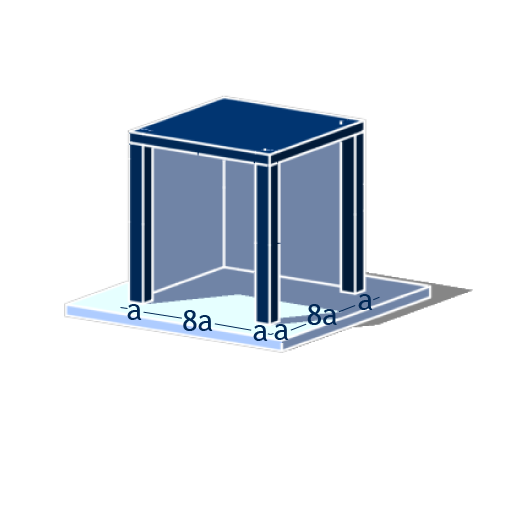
Closed 24a=60%
Open: 16a=40%
Total: 40a= 100%
Closed: 50%
Open: 50%
Closed: 62.5%
Open: 37.5%
Closed: 50%
Open: 50%
Closed: 62.5%
Open: 37.5%

Closed: 20a =42%
Open: 28a = 58%
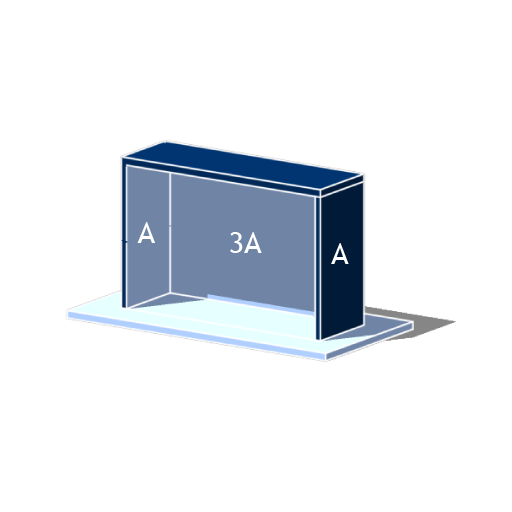
Closed: 5A= %62.5
Open:3A= %37.5
Closed:
(A+B)x2=(70+35)x2
Total=210
(Window and door openings on facade B are counted as closed since they’re not considered permanent openings.)
Total Perimeter: (70×2)+(35×2)=210
Enclosed/Perimeter x 100= (210/210)x100= 100% Enclosed
So in this example, all surfaces will be considered closed then it does not comply with Smoke Free Legislation and smoking cannot be permitted.
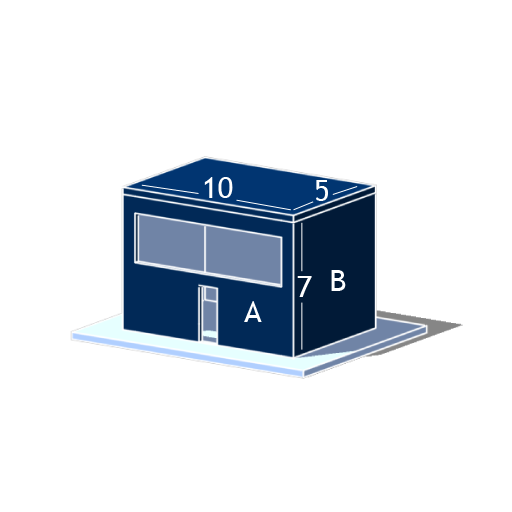
Closed:
(A+B)x2=(70+35)x2
Total=210
(Window and door openings on facade B are counted as closed since they’re not considered permanent openings.)
Total Perimeter: 210
Total Area (210) -Enclosed Area (210)=Open Space (0)
So in this example, all surfaces will be considered closed then it does not comply with Smoke Free Legislation and smoking cannot be permitted.
Closed:
A+B=7x10x2=140
Total Perimeter: 210
Enclosed/Perimeter x 100=
(140/210)x100= 66% Enclosed
If your smoking area / shelter is more than 50% enclosed then it does not comply with Smoke Free Legislation and smoking cannot be permitted.

Closed:
A+B=7x10x2=140 (Total Enclosed Area)
Total Perimeter: 210
Total Area-Enclosed Area= Open Space 210-140=70
If the open area is less than the enclosed area, the shelter will not comply with legislation.
As this open area in the example is less than the enclosed area, the shelter would not be compliant.
Closed:
A+D=10x5x2=100
B+C=5x3x2=30
E=10×10=100
Total Enclosed Area=230
Open: 20+(50×3)=170
Total Perimeter: 400
(Enclosed/ Perimeter) x100=
(230/400) x 100 = 57.5% Enclosed
If your smoking area / shelter is more than 50% enclosed then it does not comply with Smoke Free Legislation and smoking cannot be permitted.

Closed:
A+B=7x10x2=140 (Total Enclosed Area)
Total Perimeter: 210
Total Area-Enclosed Area= Open Space 210-140=70
If the open area is less than the enclosed area, the shelter will not comply with legislation.
As this open area in the example is less than the enclosed area, the shelter would not be compliant.
Closed:
A+D+E= 10x10x3=300
B+C= 5x3x2=30
Total Enclosed Area=330
Open:20+50=70
Total Perimeter 400
Enclosed/Perimeterx100=
(330/400) x100= 82.5% Enclosed
If your smoking area / shelter is more than 50% enclosed then it does not comply with Smoke Free Legislation and smoking cannot be permitted.
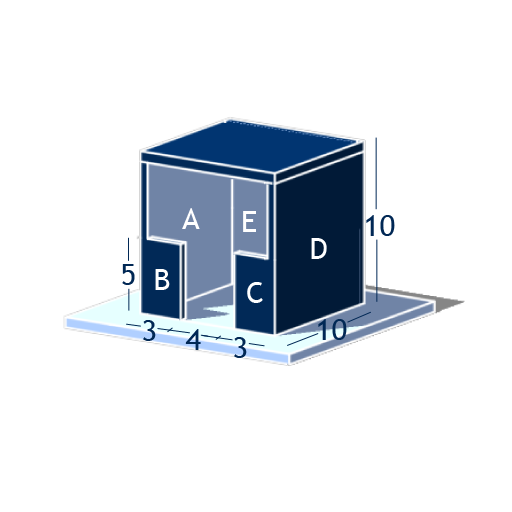
Closed:
A+D+E= 10x10x3=300
B+C= 5x3x2=30
Total Enclosed Area= 330
Open: 20+50=70
Total Perimeter: 400
Total Area-Enclosed Area= Open Space 400-330=70
If the open area is less than the enclosed area, the shelter will not comply with legislation.
As this open area in the example is less than the enclosed area, the shelter would not be compliant.
Closed:
A+B=3x10x2= 60
C+D= 10x5x2= 100
E=100
Total Enclosed Area=260
Total Perimeter 400
Enclosed/Perimeterx100=
(260/400) x100=65% Enclosed
If your smoking area / shelter is more than 50% enclosed then it does not comply with Smoke Free Legislation and smoking cannot be permitted.
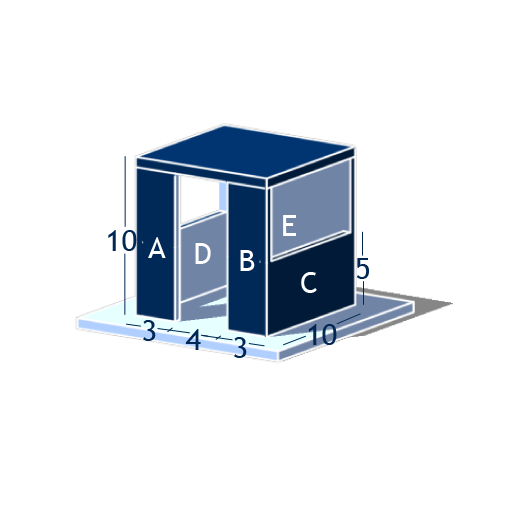
Closed:
A+B= 3x10x2=60
C+D= 10x5x2=100
E=100
Total Enclosed Area= 260
Total Perimeter: 400
Total Area-Enclosed Area= Open Space 400-260=140
If the open area is less than the enclosed area, the shelter will not comply with the legislation.
As this open area in the example is less than the enclosed area, the shelter would not be compliant.
Closed:
A+B+C= (5x10x2) + (10×10)
Total Enclosed Area=200
Open: (5x10x2)+ (10×10)= 200
Total Perimeter 400
Enclosed/Perimeterx100=
(200/400) x100=50% Enclosed
If your smoking area / shelter is less than or equal to 50% enclosed then it complies with Smoke Free Legislation and smoking can be permitted.

Closed:
A+B+C= (5x10x2) + (10×10)
Total Enclosed Area= 200
Open: (5x10x2) + (10×10)=200
Total Perimeter: 400
Total Area-Enclosed Area= Open Space
400-200= 200
If the open area is less than the enclosed area, the shelter complies with legislation.
As this open area in the example is equal to the enclosed area, the shelter would be compliant.
Smoke-free legislation applies to premises:
The term “work” also includes volunteer work, thus if a village hall hosts an event with volunteers working there, it must be smoke-free. It would be both a workplace and a public space if the general public attended.
A place that is covered by a roof or ceiling is known as a smoking shelter or structure. It need not have walls; it could simply be a space with a canopy.
For a more enclosed feeling, the smoking shelter can have back and sides. However, it legally can not be fully enclosed.
Employers may designate a smoking room if the policy prohibits smoking in bedrooms, but it must adhere to the requirements outlined above. The administration will also decide whether guests can smoke in smoking rooms. Staff members are not permitted to use the smoking rooms and they may not be utilised for entertainment.
Outside areas are not covered by the legislation. To prevent employees and guests from having to enter the building through a smoke-filled hallway, companies may adopt a policy that smoking is not permitted within a specific distance of exterior entrances.
DISCLAIMER: There are numerous caveats and restrictions. Because of the generality of this update, the information provided herein may not be applicable in all situations. A comprehensive review would be required for certainty. The information contained on this website is for general information purposes only.
Please contact us for further information and a more detailed assessment. If you are in any doubt, you should contact your Local Authority before undertaking any work. Whilst we endeavour to keep the information up to date and detailed, Se & Se Consultancy Ltd. makes no representations or warranties about the accuracy with respect to information of any kind without a detailed assessment and/or Local Authority confirmation.
Se & Se Consultancy Ltd. 2022 |
Planning and Architectural Specialists
Did our examples help you to build a smoking shelter?
You can download this web page as a Guidance E-Book for free and share !
↓ Click image to enlarge PDF ↓
50% Open Space Rule for Smoking AreaDo you want to keep up to date?
Click one of our representatives below to chat on WhatsApp